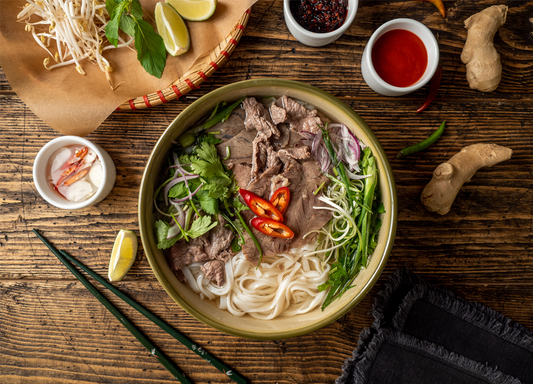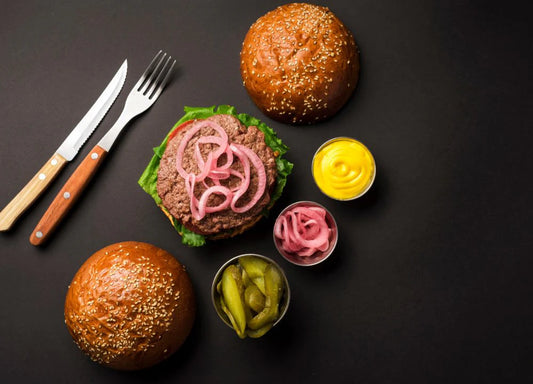Pho and Health: Nutritional Benefits of This Classic Vietnamese Dish

Introduction: A Nutritious Delight
Pho, the iconic Vietnamese noodle soup, is celebrated for its aromatic broth, tender meat, and fresh herbs. Beyond its delicious taste, pho offers a range of nutritional benefits that make it a healthful choice. This classic dish, which has evolved from humble street food to a global favorite, provides essential nutrients and can be adapted to meet various dietary needs. This article explores the nutritional benefits of pho, highlighting its healthful components and how it can be enjoyed as part of a balanced diet.
1. Nutritional Profile of Pho
Pho is typically composed of a rich broth, rice noodles, meat (usually beef or chicken), and a variety of fresh herbs and vegetables. Each component of pho contributes to its overall nutritional profile.
1.1. The Broth: A Source of Essential Nutrients
The broth is the heart of pho and plays a significant role in its nutritional benefits. Traditionally made from simmered beef bones or chicken carcasses, the broth is rich in:
- Collagen: The long simmering process extracts collagen from the bones, which is beneficial for skin, joint, and gut health.
- Amino Acids: Broth contains amino acids like glycine and proline, which support various bodily functions including muscle repair and immune system health.
- Minerals: The broth provides essential minerals such as calcium, magnesium, and phosphorus, which are important for bone health and overall well-being.
1.2. Rice Noodles: Carbohydrates for Energy
Rice noodles are a primary component of pho, providing a source of carbohydrates. They offer:
- Quick Energy: Carbohydrates from rice noodles are a quick source of energy, making pho a satisfying meal.
- Low Fat: Rice noodles are naturally low in fat, which can contribute to a balanced diet.
1.3. Meat: Protein and Nutrients
The meat in pho, usually beef or chicken, contributes significant nutritional value:
- Protein: Both beef and chicken are high in protein, which is essential for muscle growth, repair, and overall body function.
- Iron: Beef is particularly rich in heme iron, which is easily absorbed by the body and supports healthy blood cells.
- Vitamins: Meat provides essential vitamins such as B vitamins, which are important for energy metabolism and brain health.
1.4. Fresh Herbs and Vegetables: Vitamins and Antioxidants
Pho is typically garnished with fresh herbs (like basil and cilantro) and vegetables (such as bean sprouts and lime). These ingredients add:
- Vitamins: Fresh herbs and vegetables are rich in vitamins A, C, and K, which support immune function, skin health, and blood clotting.
- Antioxidants: Herbs and vegetables contain antioxidants that help combat oxidative stress and inflammation.
- Fiber: Vegetables and herbs contribute dietary fiber, which supports digestive health.
2. Health Benefits of Pho
Pho offers several health benefits thanks to its well-balanced and nutritious components.
2.1. Supports Joint and Skin Health
The collagen extracted from the bones during the broth-making process can support joint health and skin elasticity. Collagen helps maintain the integrity of connective tissues and may reduce the signs of aging.
2.2. Boosts Immune Function
The vitamins and minerals in pho, especially those from fresh herbs and vegetables, contribute to a robust immune system. Vitamin C, found in ingredients like lime and cilantro, is known for its immune-boosting properties.
2.3. Provides Balanced Nutrition
Pho offers a balanced combination of protein, carbohydrates, and healthy fats. The meat provides high-quality protein, while the rice noodles offer energy-giving carbohydrates. Fresh herbs and vegetables enhance the dish's nutritional profile with essential vitamins and minerals.
2.4. Aids Digestion
The broth's warm temperature and hydrating properties, combined with the fiber from vegetables, can aid digestion and promote a healthy gut. The soup's fluid content can also help keep the body hydrated.
3. Modifying Pho for Health-Conscious Diets
Pho can be easily adapted to meet various dietary needs while retaining its nutritional benefits.
3.1. Plant-Based Pho
For those following a vegetarian or vegan diet, pho can be made with plant-based broths and meat substitutes. Options include:
- Vegetable Broth: A rich vegetable broth can replace traditional beef or chicken broth.
- Tofu or Seitan: These plant-based proteins can substitute for meat, providing a source of protein and other nutrients.
3.2. Gluten-Free Pho
Traditional pho noodles are made from rice flour, which is naturally gluten-free. For added assurance, restaurants and home cooks can use dedicated utensils to avoid cross-contamination, ensuring that pho remains a safe option for those with gluten sensitivity.
3.3. Low-Carb Pho
For individuals following a low-carb diet, alternative noodles such as zucchini noodles or shirataki noodles can replace rice noodles. These substitutes offer fewer carbohydrates while still providing a satisfying texture.
3.4. Reduced Sodium Pho
To make pho lower in sodium, cooks can use less salt in the broth and opt for low-sodium soy sauce or fish sauce. Additionally, making broth from scratch allows for greater control over sodium content.
4. Enjoying Pho as Part of a Balanced Diet
Pho can be a nutritious and satisfying meal when enjoyed as part of a balanced diet. To maximize its health benefits, consider the following tips:
- Portion Control: Be mindful of portion sizes, especially when dining out, to avoid overeating.
- Balance: Pair pho with a side of vegetables or a salad to increase the meal's nutritional content.
- Customization: Adjust ingredients and toppings based on personal dietary preferences and health goals.

Conclusion: A Healthful Choice
Pho, with its rich broth, tender meat, and fresh herbs, offers a range of nutritional benefits that make it a healthful and enjoyable meal. Its combination of collagen, protein, vitamins, and minerals contributes to overall well-being and supports various aspects of health. By making thoughtful modifications, such as incorporating plant-based options or reducing sodium, pho can be adapted to meet a variety of dietary needs while retaining its beloved flavors.
As pho continues to gain popularity worldwide, its versatility and nutritional value highlight its potential to be a delicious and healthful addition to any diet. Whether enjoyed in its traditional form or with modern adaptations, pho remains a testament to the rich culinary heritage of Vietnam and its ability to nourish both body and soul.




